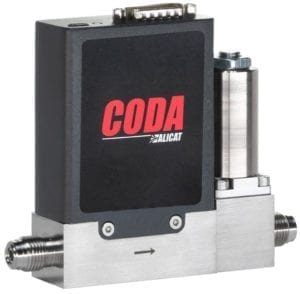- Blog
- Coriolis flow meters in semiconductor processes
Coriolis flow meters in semiconductor processes
High accuracy and precision flow metering and control are critical for many semiconductor manufacturing techniques. These processes require tight liquid controls, and Coriolis flow meters and controllers are ideal for low-flow applications. They provide several benefits which make them an optimal choice for semiconductor processes including chemical vapor deposition (CVD). In this article, we will discuss the semiconductor industry and the role of Coriolis mass flow technology in it.
Semiconductors
Semiconductors are a crucial component of modern technology, found in nearly every single electronic device from smartphones and computers to washing machines. They possess an intermediate conductivity somewhere between conductors and insulators which can be manipulated through the doping of select impurities. For example, silicon is the most commonly used semiconductor material and can be doped with a mere 0.0001% boron to increase conductivity by a thousand times. This manipulability along with their unique properties make semiconductors a key component of integrated circuits which are found in a majority of electronic systems.
Moore’s law famously predicts that the number of transistors in an integrated circuit doubles approximately every two years. While this trend is now beginning to slow due to the physical limits of miniaturization, it remains a strong driving force for the rapid growth and development of the semiconductor industry. Semiconductor-based components are constantly improving in terms of compactness, performance, efficiency, and cost.
Semiconductor fabrication involves an extensive list of processing techniques. For integrated circuit chips, a cylindrical silicon ingot is sliced thin into “wafers” which are then cleaned and polished before being subjected to various additive and subtractive processing steps. One critical step is a technique called chemical vapor deposition (CVD).
Chemical vapor deposition (CVD)
Chemical vapor deposition is a process by which thin film layers are deposited uniformly onto a substrate – for the manufacturing of semiconductor integrated circuits, the substrate is typically a silicon wafer. CVD is able to create films with high electrical resistance which are ideal for use in integrated circuits that often have complex geometries. The process can be described simply in a few steps:
- The substrate (a silicon wafer, in this case) is loaded into the vacuum chamber.
- The liquid precursors are precisely flowed from storage tanks into an adjacent vaporization area using mass flow controllers.
- The volatile precursors are vaporized by an increase in heat and/or decrease in pressure.
- The now gaseous precursors enter the vacuum chamber and react to form polymer deposits on the substrate material’s surface.
- Any volatile byproducts are removed through an exhaust by a lateral gas flow through the chamber.
The role of Coriolis for CVD
Because CVD is a high precision process which requires exact dosing of precursor fluids, low-flow Coriolis flow controllers are an ideal choice for liquid precursor control. The Coriolis operating principle ensures flow rate is measured accurately regardless of fluid properties and composition, meaning recalibration is not necessary if the liquid precursors are changed. The accuracy is also unaffected by changing temperatures and pressures. Furthermore, a lack of required annual recalibration means that process downtime and long term ownership costs are reduced. Coriolis flow devices can also be used for gas precursors, and the same instrument can be used for both gas and liquid.
Other semiconductor processes for Coriolis
These features also make Coriolis flow meters and controllers an attractive choice for other semiconductor fabrication processes. For example, atomic layer deposition (ALD) similarly uses precursor fluids that can be precisely dosed with Coriolis instruments.
Another key process in semiconductor fabrication is the cleaning of silicon wafers after they are sliced from cylindrical silicon ingots. A newer method for wafer cleaning involves the use of supercritical CO2, which possesses special properties that make it effective at cleaning deep trenches and stripping residues. Because supercritical CO2 is neither a liquid nor a gas, Coriolis flow meters are well suited for the process.
Alicat’s CODA-Series of Coriolis instruments can provide an additional benefit to these semiconductor processes by being highly insensitive to vibrations and disturbances which may occur within close proximity. CODA is available in several models and is highly customizable; please contact Alicat to determine the best fit for your CVD, ALD, supercritical CO2, or other processes.
Fun fact: CVD coating and the liquid controls Coriolis meters provide are not just used in the semiconductor industry. CVD is also used in manufacturing potato chip bags to deposit aluminum onto polypropylene layers. Coincidentally, Coriolis flow meters are no strangers to the production of potato chips, and are also used in the seasoning process.
